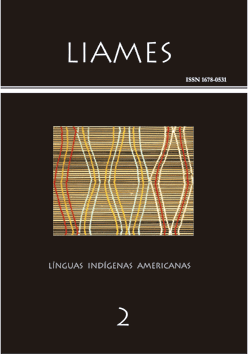Resumo
A special class of bound morphemes, called “floating” morphemes, is examined in the Apurinã (Arawak/Maipure) language of Brazil. These “floating” morphemes share both properties of affixes and of independent words in a manner reminiscent of cliticization phenomena. After comparing the ways that “floating” morphemes are similar and different from typical affixes and from typical independent words, the author investigates these special morphemes in the context of cliticization, arriving at two main conclusions: (i) although “floating” morphemes share a number of properties with clitic elements, they also pose a problem to the current typology of clitics, and (ii) they do not show the sort of uniform behavior expected from a class of special clitics, pointing to the need for a better understanding of the ways in which phonological forms can interact with the principles of organization of both word and sentence structures.Referências
ANDERSON, Stephen (1988). Morphological Theory. In: Newmeyer (1988), vol. 1, pp. 146-191.
CRAIG, Colette G. (ed.) (1986). Noun Classes and Noun Classification. Amsterdam: John Benjamins.
DELANCEY, Scott (1984). Notes on Agentivity and Causation. Studies in Language 8:181-213.
DELANCEY, Scott (1986). Towards a history of Thai a classifier system. In: Craig (ed.) (1986), pp. 437-452.
DELANCEY, Scott (1991). Event Construal and Case Role Assignment. Berkeley Linguistic Society.
FACUNDES, Sidney da S. (2000a). The Language of the Apurinã People of Brazil. Tese de Ph.D., SUNY-Búfalo: Búfalo.
DELANCEY, Scott (2000b). Historical Linguistics and Its Contribution to Improving the Knowledge of
Arawakan. In: J. D. Hill e F. Santos-Granero (Eds. 2002). Comparativ e Arawakan Histories.
Urbana/Chicago: University of Illinois Press, pp. 74-96.
KLAVANS, J. (1985). The Independence of Syntax and Phonology in Cliticization. In: Language, 61: 95-120.
NEVIS, Joel A. (1985). Finish Particle Clitics and General Clitic Theory. Tese de Ph.D., Ohio
State University: Columbus.
NEWMEYER, Frederick J. (1988). Linguistic Theory: Foundations. Linguistics: The Cambridge Survey, vol. 1. Cambridge: Cambridge University Press.
SADOCK, Jerrold M. (1991). Autolexical Syntax: a Theory of Parallel Grammatical
Representations. Chicago: University of Chicago Press.
ZWICKY, Arnold M. (1977). On Clitics. Bloomington: Indiana University Linguistic Club.
ZWICKY, Arnold M. (1985). Clitics and Particles. In: Language, 61:283-305.
ZWICKY, Arnold e PULLUM, G. K. (1983). Cliticization vs. Inflection: English n’t. In: Language, 59:502-13.
A LIAMES: Línguas Indígenas Americanas utiliza a licença do Creative Commons (CC), preservando assim, a integridade dos artigos em ambiente de acesso aberto.
Os artigos e demais trabalhos publicados na LIAMES: Línguas Indígenas Americanas, publicação de acesso aberto, passa a seguir os princípios da licença do Creative Commons. Uma nova publicação do mesmo texto, de iniciativa de seu autor ou de terceiros, fica sujeita à expressa menção da precedência de sua publicação neste periódico, citando-se a edição e a data desta publicação.

